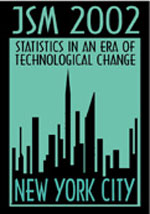|
Activity Number:
|
109
|
|
Type:
|
Contributed
|
|
Date/Time:
|
Monday, August 12, 2002 : 10:30 AM to 12:20 PM
|
|
Sponsor:
|
Section on Survey Research Methods*
|
| Abstract - #301140 |
|
Title:
|
Reflecting Uncertainty Due to Possibly Nonignorable Missingness for Unresolved Coverage Evaluation Survey Cases
|
|
Author(s):
|
Thomas Belin*+ and Donald Keathley and Rita Petroni and Donald Rubin and Bruce Spencer
|
|
Affiliation(s):
|
University of California, Los Angeles and U.S. Census Bureau and U.S. Census Bureau and Harvard University and Northwestern University
|
|
Address:
|
Room 51-267 CHS, Los Angeles, California, 90095, United States
|
|
Keywords:
|
undercount estimation ; logistic regression ; post-enumeration survey ; match status ; order statistics ; enumeration status
|
|
Abstract:
|
Because field work cannot resolve all discrepancies in census coverage evaluation surveys, statistical procedures are needed to handle unresolved cases. Belin, et al. (1993 JASA) described a logistic regression model for a 1990 post-enumeration survey (PES) data that could be fitted based on individuals resolved during follow-up interviewing, making it an ignorable model. Wachter (1993 JASA) criticized the 1990 PES procedures for not reflecting the possibility of nonignorable missingness in estimates of total error for undercount estimates. This talk will discuss a strategy developed to reflect possible nonignorable missingness in the evaluation of 2000 Accuracy and Coverage Evaluation (A.C.E.) estimates. The key idea is to anchor the magnitude of nonignorable effects to an order statistic for the absolute values of coefficients in a logistic regression model for 2000 A.C.E. data. The order statistic is chosen such that a similar procedure would account for departures between observed match rates and average predicted probabilities for cases resolved during 1990 evaluation follow-up interviewing. The method will be illustrated with examples from 2000 A.C.E. processing.
|

